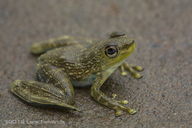|
Staurois latopalmatus (Boulenger, 1887)
Sabah Splash Frog, Rock Skipper | family: Ranidae genus: Staurois |
| Species Description: Boulenger, G. A. (1887). On new reptiles and batrachians from North Borneo. Annals and Magazine of Natural History, Series 20(5), 95–97 | |
 © 2020 Lars Fehlandt (1 of 6)
|
|
|
|
Description The species is very unique-looking and can be easily distinguished from all sympatric species, including other Staurois species by the pug-like snout (Boulenger 1887, Inger et al. 2017). Life coloration consists of a dark brown to black dorsal color, with small, bright mottles, which in some specimens form a web-like pattern on the back; hind limbs with lighter cross bands; ventral surface white. The upper 2/3 of the iris is often orange to red, the lower part beige to silver (Boulenger 1887, Inger et al. 2017). Intensity and density of the dorsal pattern varies tremendously, and can also be more yellow than white. Furthermore, several photos published online also show individuals with a brighter ground coloration, tending towards light olive-green (Boulenger 1887, Inger et al. 2017). Distribution and Habitat Country distribution from AmphibiaWeb's database: Indonesia, Malaysia Malaysian region distribution from AmphibiaWeb's database: Sabah, Sarawak
Staurois latopalmatus mainly occurs in primary forests but can also be found in disturbed areas, as long as some tree cover still exists along the stream banks (Inger et al. 2017). Life History, Abundance, Activity, and Special Behaviors
Like in other Staurois species, males perform foot-flagging for visual communication (Preininger et al. 2009). The food of S. latopalmatus consists of aquatic insect larvae, which they probably pick up from submerged rock surfaces (Inger et al. 2017). Larva
Trends and Threats Possible reasons for amphibian decline General habitat alteration and loss Comments References Boulenger, G. A. (1887). On new reptiles and batrachians from North Borneo. Annals and Magazine of Natural History, 20(5), 95–97 [link] Frost, D. R. (2023). Amphibian Species of the World: an Online Reference. Version 6.2 (20.11.2023). Electronic Database accessible at https://amphibiansoftheworld.amnh.org/index.php. American Museum of Natural History, New York, USA. Haas, A., Das, I., Hertwig, S. T., Bublies, P., and Schulz-Schaeffer, R. (2022). A Guide to the Tadpoles of Borneo. tredition. Haas, A., Das, I., and Hertwig, S. T. (2024). Frogs of Borneo – The frogs of East Malaysia and their larval forms. Electronic Database accessible at http://www.frogsofborneo.org. Visited online on 02.03.24. Inger, R. F., Stuebing, R. B., Grafe, U., and Dehling, J. M. (2017). A Field Guide to the Frogs of Borneo. Natural History Publications (Borneo) Limited, Kota Kinabalu. IUCN SSC Amphibian Specialist Group. (2018). Staurois latopalmatus. The IUCN Red List of Threatened Species 2018: e.T58761A114924500. https://dx.doi.org/10.2305/IUCN.UK.2018-1.RLTS.T58761A114924500.en. Accessed on 04 March 2024. Matsui, M., and Seto, T. (1985). Karyotype of an Asian ranid frog, Staurois latopalmatus. Japanese Journal of Herpetology, 11, 1-4. [link] Preininger, D., Boeckle, M., and Hödl, W. (2009). Communication in noisy environments II: visual signaling behavior of male foot-flagging frogs Staurois latopalmatus. Herpetologica, 65(2), 166-173. [link]
Originally submitted by: Frederic Griesbaum (2024-03-04) Description by: Frederic Griesbaum (updated 2024-03-04)
Distribution by: Frederic Griesbaum (updated 2024-03-04)
Life history by: Frederic Griesbaum (updated 2024-03-04)
Larva by: Frederic Griesbaum (updated 2024-03-04)
Trends and threats by: Frederic Griesbaum (updated 2024-03-04)
Comments by: Frederic Griesbaum (updated 2024-03-04)
Edited by: Ann T. Chang (2024-03-04) Species Account Citation: AmphibiaWeb 2024 Staurois latopalmatus: Sabah Splash Frog <https://amphibiaweb.org/species/5190> University of California, Berkeley, CA, USA. Accessed Apr 17, 2024.
Feedback or comments about this page.
Citation: AmphibiaWeb. 2024. <https://amphibiaweb.org> University of California, Berkeley, CA, USA. Accessed 17 Apr 2024. AmphibiaWeb's policy on data use. |




 Map of Life
Map of Life